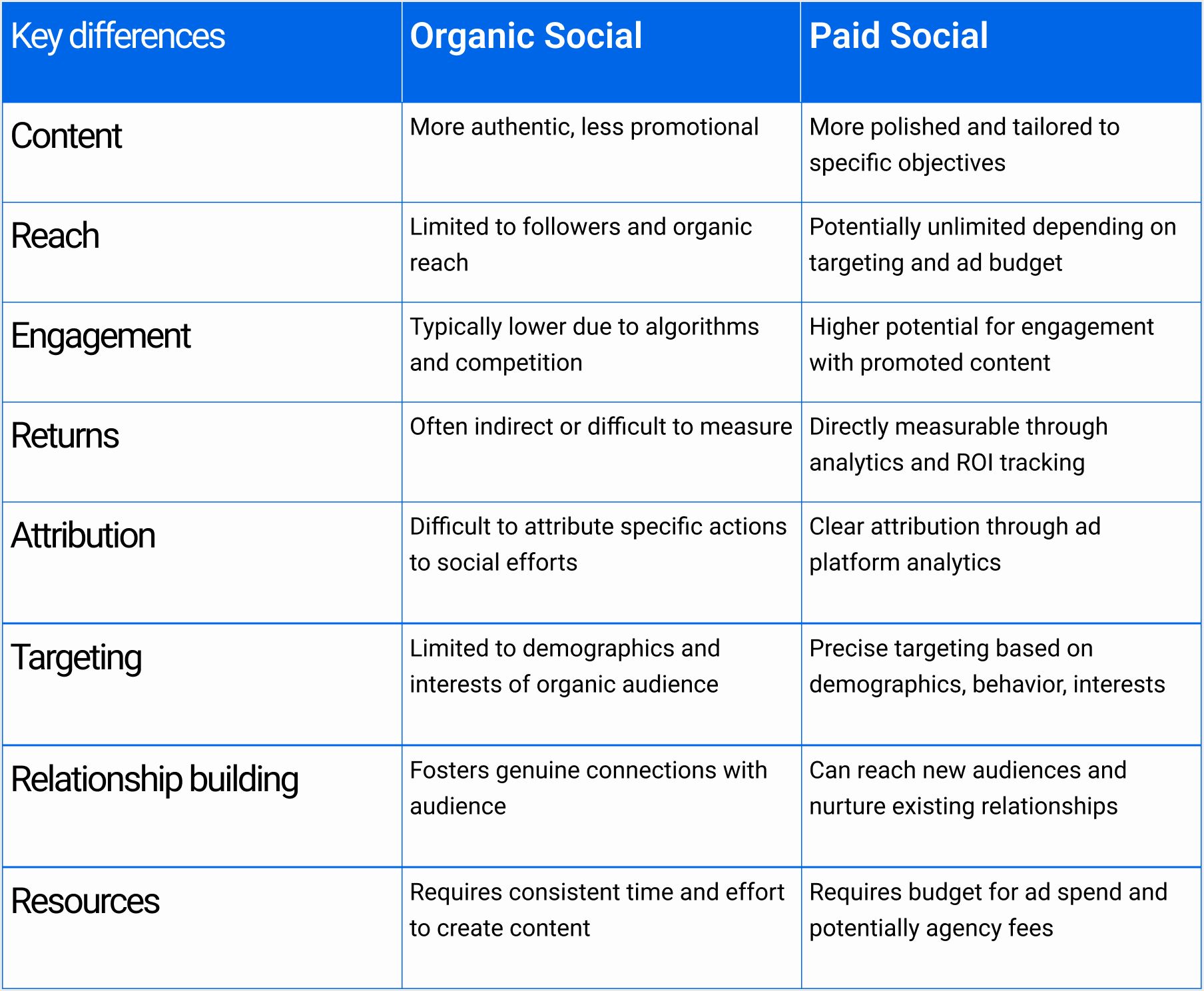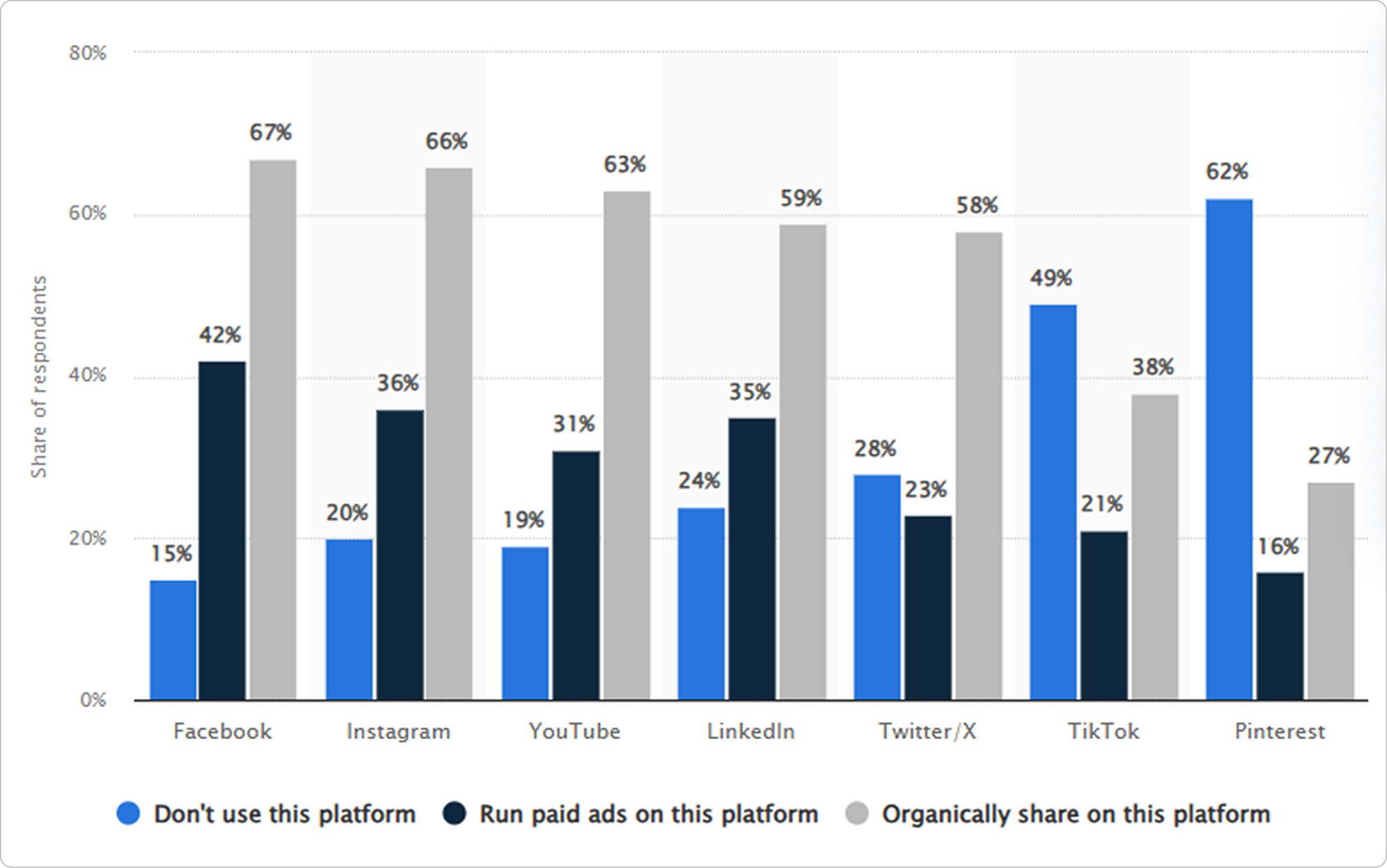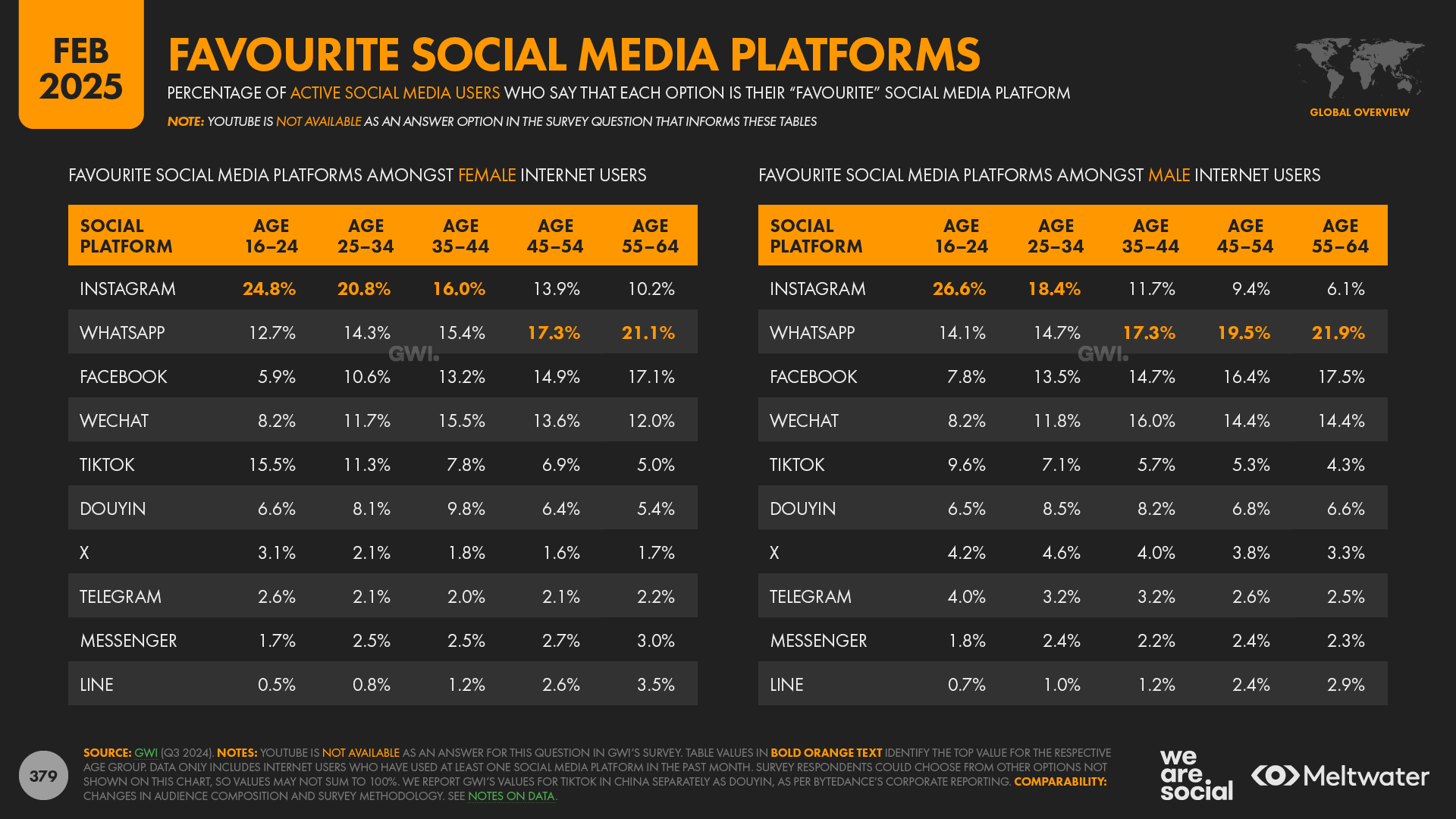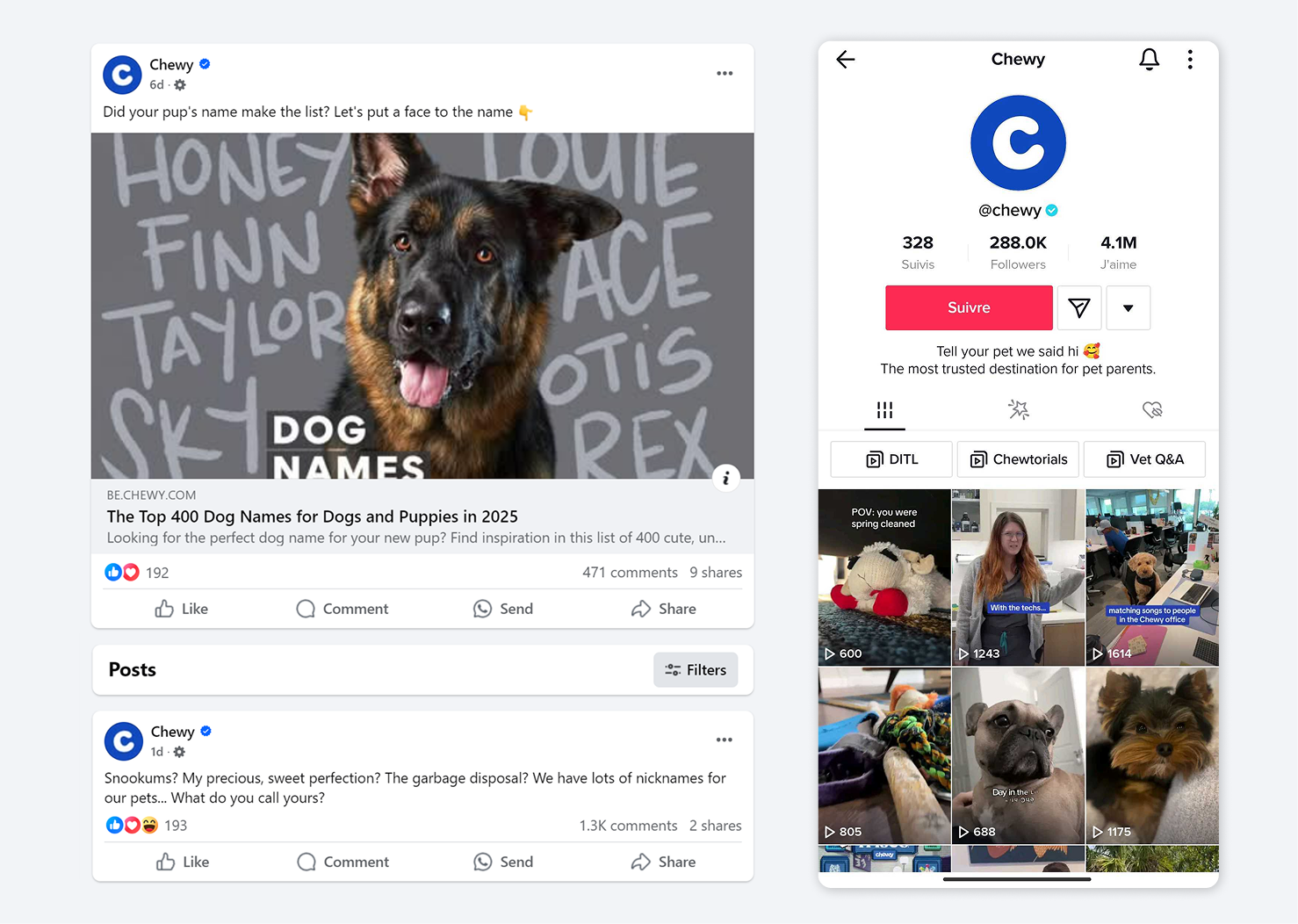Organic Social Media Growth: Why It Matters
2025-03-01

You've heard people say that organic social is dead. After all, social media has become a crowded space where algorithms favor paid ads. Brands have to “pay to play”, and organic posts just don’t have the same reach as before.
But the truth is, organic social media has just evolved. While brands once relied on viral reach, today it’s about building lasting relationships.
In this article, we’ll break down why organic social media still matters, how it compares to paid social, and what it takes to grow in 2025. Plus, we’ll share real examples of brands making organic work.
What is organic social?
Organic social, or organic social media, includes any content you share on social platforms without paying to boost or promote it.
Think of your Instagram posts, LinkedIn updates, TikTok videos, and Facebook stories — if you post it and let the platform’s algorithm do its thing without paying to show it to people, that’s organic social media.
This type of content isn’t just about visibility — it’s about engagement and community-building. Brands that succeed focus on content that starts conversations, strengthens relationships, and fosters brand loyalty.
Here are the organic content types that drive the most engagement:
- Conversational content — founder posts, personal stories, and behind-the-scenes glimpses that make brands feel more human.
- User-generated content (UGC) — not just reposting customer content but actively engaging with and amplifying your community’s voice.
- Educational and insight-driven posts — actionable tips, industry insights, and value-packed content that positions your brand as a trusted resource.
- How-to guides and tutorials — practical, problem-solving content that helps your audience while showcasing your expertise.
- Memes and cultural commentary — playful, relatable content that taps into trends and connects with audiences on a personal level.
- Product updates with a storytelling angle — framing new features as part of a bigger brand journey instead of making generic announcements.
- Short-form videos and interactive content — quick, engaging clips (like TikToks and Reels), polls, and Q&As that invite audience participation.
The key is that the best organic content feels like a conversation, not a campaign. Brands that invest in authentic, relationship-driven content see stronger engagement and long-term customer loyalty.
But is organic social as effective as paid social, and what benefits can it offer to your business?
Organic social vs. Paid social: key differences
When it comes to social media marketing, there are two main approaches — organic social and paid social. While both can help grow your business, they work in different ways.
Organic social focuses on long-term relationship-building. It’s about creating valuable content that engages your audience, encourages conversations, and strengthens brand loyalty. Rather than quick wins, it builds a foundation of trust and credibility over time — much like community-building or word-of-mouth marketing.
Organic social media marketing includes planning, creating, and curating organic social media content, as well as interacting with people. But, organic marketing takes time. Growth isn’t instant, and it requires consistent effort to create valuable content that keeps people coming back.

Key differences between organic social and paid social
Paid social, on the other hand, is designed for instant visibility — you can pay for ads or boost posts on social media platforms to reach people who may not already follow you.
Paid social helps you connect with potential customers quickly by targeting specific groups of people, which is great for running promotions, launching new products, or expanding reach beyond your existing followers.
However, paid social can be quite expensive, and it has a short-term focus — reaching specific goals within a specific timeframe.
So, which one should you focus on? Experience shows that successful strategy isn’t about choosing one over the other — it’s about using both strategically.

Most marketers use both organic social and paid social strategies. Source: Statista
Use organic social to:
- Nurture relationships with existing followers,
- Share your brand story and build credibility,
- Offer customer support and foster engagement,
- Create a loyal, engaged community over time.
Use paid social to:
- Reach a broader or more targeted audience,
- Promote new products or time-sensitive offers,
- Retarget previous visitors or users who interacted with your content,
- Boost a high-performing organic post to increase its reach.
In short, each strategy has its own applications and use cases, and the best results come from a hybrid marketing strategy. Paid social can quickly generate attention for your business, while organic content can keep your brand relevant and engaging in the long run.
Now, let’s talk about what makes organic social a must-have for your business.
Benefits of using organic social media
So, organic social isn’t just about getting content out there — it’s about earning attention and keeping it. This takes time, effort, and creativity.
That’s why organic social might seem a lot harder than just running paid social ads, but organic social media growth is definitely worth the effort.
Here’s why:
It builds trust
People don’t go on social media just to see ads — they want to see content that entertains them or provides some form of value. Businesses that can tap into that are much more easily remembered and trusted by consumers than those who don’t. And when people trust your brand, they’re more likely to engage and eventually buy from you.
It humanizes your brand
People love to connect with people, not faceless companies. Sharing behind-the-scenes moments, showing your team, offering useful tips and tricks, and even simply posting memes — all of that can give your brand a personality. Brands with strong personalities are more relatable, which helps them build deeper customer relationships.
It creates a loyal community
Strong brands don’t just have customers; they have loyal fans. The power of quality organic content lies in its ability to make people interested in your business even if they’re not your target audience.
When you share useful, fun, or inspiring content, people start to engage — not just with you, but with each other. They comment, share, and spread the word. Over time, this builds a loyal community that sticks around, even when you’re not running ads.
It keeps your audience engaged
Organic social media is helping you not just get new followers but also keep the ones you already have — posting regularly keeps your brand top of mind. Whether it’s a quick tip, a funny meme, or a behind-the-scenes video, organic content reminds people why they followed you in the first place.
Also, when customers tag your brand, leave reviews, or share their experiences, you can reshare that content, using UGC as social proof.
It pays off in the long run
Even with the ever-changing social media algorithms, high-quality content still gets shared. If your posts are valuable, entertaining, or relatable, people will like, comment, and share them, helping you reach a wider audience without extra costs.
Also, unlike paid ads, which stop working the moment you stop spending, organic content stays visible just because it’s that good. A great post can keep bringing in traffic and engagement for days, weeks, or even months. It’s a long-term strategy that keeps your brand growing.
But how much will it cost you?
How much does organic content cost?
When people talk about the benefits of organic social media content, they often say it’s cheaper than paid ads. But the truth is, organic content isn’t really free. While you don’t have to pay for ads, there are still costs involved.
Good content takes time. You can’t just post randomly and expect results — it takes planning, creativity, and consistency. You need to come up with ideas, design graphics or videos, write captions, and stay proactive in engaging with your audience. That time and effort? That’s a cost too.
Second, organic social marketing needs consistency: posting once in a while won’t cut it. To keep your audience interested, you need to keep posting valuable content regularly. You need to know what your audience likes, respond to comments, and keep up with trends.
So while organic content might not have a direct cost like paid ads, it still requires a lot of time and effort to make it work. Also, you still need to spend money on it.
For instance, WebFX’s data shows that 55% of businesses dedicate 11-50% of their marketing budget to content marketing, with 58% of businesses spending $5,001-$10,000 per month on content marketing in general and 31% spending up to $3,000 per month on social media content in particular.
It might sound pricey, but 77% of businesses see great ROI and keep investing. This shows that social media content is a priority for the majority of businesses, and it drives real results for them.
Bottom line: organic social isn’t cheap, but it’s worth it if you have a solid strategy.
Key tips for effective organic social media strategy
1. Choose the right platforms
Before you post, figure out where your audience spends time — the last thing you want is to waste effort on platforms where your customers aren’t active.
A good way to find this out is to ask your customers. A simple email survey or a poll on your page can show which social media platforms your existing customers prefer. This will help you invest in the right channels instead of spreading yourself too thin.
Also, check where your competitors are posting — your audience is probably there too. Pay attention to their engagement levels. Are their followers actively commenting and sharing, or is their content falling flat? This can give you an idea of how strong the organic reach is on that platform.

Favourite social media platforms based on age and gender. Source: GWI via Datareportal
Finally, look at platform demographics and match them to your target audience. For example, Instagram and TikTok are ideal for reaching younger users, while Facebook and LinkedIn are best for reaching older demographics.
Once you know where to focus, you can channel your time, effort, and resources into what works.
2. Cross-post and adapt your content to each platform
Posting on multiple platforms helps you reach more people. But just as not all social media platforms work the same way, your content shouldn’t either.
Instead of copying and pasting the same post everywhere, tweak it to fit each platform’s style and audience. Here’s how:
- Optimize for platform requirements — each platform has different image sizes, caption lengths, hashtag rules, etc. Learn these guidelines and make sure your posts follow them.
- Match the platform’s style and tone — adapt your content to fit the platform’s culture. What works on LinkedIn (professional insights or thought-leader content) won’t necessarily take off on TikTok, and vice versa.
- Use AI tools — AI content creation tools can help you repurpose content for different platforms, saving time while keeping your posts relevant.
As they say, when in Rome, do as Romans do. Think of it as speaking the local language: each social media platform has its own trends, inside jokes, memes, and ways of engaging. If you get familiar with things that make each platform unique, you can make your content fit just right no matter where you post it.
3. Experiment with different formats
Not all content performs the same. Some formats help you go viral, others build deeper connections. The key to a strong organic strategy is mixing it up and seeing what works.

Chewy posts different types of content on their social media pages: from simple text posts to photos and videos
Try these formats to keep things fresh and engaging:
- Videos — short clips, as well as longer videos, tend to get more views than static images. Use them to show tutorials, behind-the-scenes moments, or something light and fun to grab attention.
- Carousels — multi-image posts make people swipe through, keeping them engaged longer. Use them for step-by-step guides, product showcases, or storytelling.
- Polls and quizzes — these interactive posts not only boost engagement but also give you insights into what your audience thinks and wants. They don’t have to be completely serious — you can use them as a fun conversation-starter as well.
- Stories — since they disappear in 24 hours, Stories create a sense of urgency. Use them for quick updates, sneak peeks, or interactive Q&As.
- Text-based posts — thought-provoking questions, relatable stories, or even a simple question can start discussions and boost engagement.
- Memes and GIFs — the right meme at the right time can make your followers laugh and maybe even go viral. Just make sure it aligns with your brand’s personality and your audience’s interests.
Want to know what works? Experiment: try different formats, see what gets people talking, and double down on it.
Also, make sure you keep your organic content balanced — it should mostly be educational, entertaining, or inspiring, not promotional. People stick around for brands that entertain, educate, or inspire, not ones that just sell nonstop.
4. Plan your content with a calendar
Staying consistent on social media is much easier when you have a content calendar: it helps you stay organized, avoid last-minute stress, and stick to your goals.
A good calendar also helps you mix things up so your feed doesn’t feel repetitive. You can plan posts around key events like holidays, product launches, or industry trends while keeping a steady posting schedule — daily, weekly, or something in between.
It’s also smart to balance timely content (like memes) with evergreen posts that stay relevant (tips, how-to guides, or customer stories). This way, you won’t be constantly scrambling for new ideas.
5. Join groups and communities
Social media is all about connecting with people — so make it part of your organic strategy. Besides running your own page, you can join in on conversations that happen in your orbit.
For example, joining Facebook groups, LinkedIn communities, or Reddit discussions can help you stay in touch with your audience and learn what’s important to them.
Listen to the questions people ask, the problems they discuss, and share your knowledge instead of pushing your product. It’s a great way to spot trends and understand what your customers want.
Also, showing up in the right communities builds trust. If people see you engaging, they’ll remember you when they need what you offer, or even recommend you.
6. Engage with your audience
Want engagement? Start the conversation — social media works both ways. If you post and vanish, you’re missing out on real connections.
 Even a brief reply to your customers' comments can help you strengthen relationships with them
Even a brief reply to your customers' comments can help you strengthen relationships with them
Here’s how to keep the conversation going:
- If someone takes the time to comment, don’t leave them hanging — reply and build that connection.
- Watch for brand mentions even if you’re not tagged — this helps you gauge people’s opinions.
- Engage with others’ posts — commenting and sharing relevant posts from other accounts can boost your visibility and show your brand is part of the conversation.
If your post gets mixed reactions, use that feedback to adjust your messaging. If you notice people asking the same questions about your product, you can address them in future posts or FAQs.
7. Use keywords
SEO isn’t just for Google anymore — people search on social media platforms too, so keywords matter.
Work key industry terms into your bio and posts so people can find you easily. Make sure to use keywords naturally in your captions as well, so platforms can better understand your posts.
Mix trending and niche hashtags, but don’t go overboard — 3-5 solid ones work best. Also, don’t forget to optimize your videos and images by adding subtitles and text overlays with keywords. And always add alt text to your images with descriptive, keyword-rich text.
This not only helps with SEO but also makes your content more accessible.
8. Track what works & adjust
A strong social strategy isn’t one-and-done: you’ve got to test, tweak, and improve. To know how well your organic social strategy is performing, pay attention to these indicators:
- High-value interactions: comments, shares, and saves show strong interest.
- Low-value interactions: reach and impressions show visibility, but without engagement, they don’t mean much.
- Click-through rates: if you’re directing people to your website, track how many actually click your links.
Set a baseline engagement rate for your posts. If something performs exceptionally well (or fails instead), learn from it and tweak your content accordingly. If a certain type of post consistently underperforms, change your approach or test a new content format.
Final thoughts
Organic social media is far from dead: while paid ads can boost reach, the key to lasting success lies in consistent, valuable content that engages your audience. A balanced strategy combining both organic and paid efforts will keep your brand relevant and growing in 2025 and beyond.
For more tips on building an effective social media strategy, check out our article on the best social media tips for small businesses to create a strong presence and foster growth.

